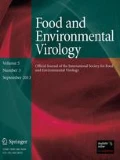Abstract
This study examined the efficacy of reovirus concentration from large volumes of water using two positively charged filters: Zeta Plus 1MDS and NanoCeram. The results indicated that an average of 61 and 81% of input reoviruses were effectively recovered, respectively, from recycled water and tap water using NanoCeram filtration.
References
Aulicino, E. A., Mastrantonio, A., Orsini, E., Bellucci, C., Muscillo, M., & LaRosa, G. (1996). Enteric viruses in a wastewater treatment plant in Rome. Water, Air and Soil Pollution, 91, 327–334.
Betancourt, W. Q., & Gerba, C. P. (2016). Rethinking the significance of reovirus in water and wastewater. Food and Environmental Virology, 8(3), 161–173.
Cashdollar, J. L., & Wymer, L. (2013). Methods for primary concentration of viruses from water samples: A review and meta-analysis of recent studies. Journal of Applied Microbiology, 115, 1–11.
Fout, G. S., & Cashdollar, J. L. (2016). EPA Method 1615. Measurement of Enterovirus and Norovirus occurrence in water by culture and RT-qPCR. II. Total culturable virus assay. Journal of the Visualized Experiments. https://doi.org/10.3791/52437.
Fout, G. S., Schaefer III, F. W., Messer, J. W., Dahling, D. R., & Stetler, R. E. (1996). Information collection rule (ICR) microbial laboratory manual. EPA/600/R-95/178. U.S. Environmental Protection Agency, Washington, DC.
Gerba, C., Betancourt, W. Q., & Kitajima, M. (2017). How much reduction of virus is needed for recycled water: A continuous changing need for assessment? Water Research, 108, 25–31.
Gibson, K. E., & Borchardt, M. A. (2016). Methods for virus recovery in water. In S. M. Goyal & J. L. Cannon (Eds.), Viruses in food (2nd ed., pp. 277–301). Cham: Springer.
Ikner, L. A., Soto-Beltran, M., & Bright, K. R. (2011). New method using a positively charged microporous filter and ultrafiltration for concentration of viruses from tap water. Applied and Environmental Microbiology, 77, 3500–3506.
Karim, M. R., Rhodes, E. R., Brinkman, N., Wymer, L., & Fout, G. S. (2009). New electropositive filter for concentrating enteroviruses and noroviruses from large volumes of water. Applied and Environmental Microbiology, 75, 2393–2399.
Payment, P., & Trudel, M. (1993). Isolation and identification of viruses. In P. Payment & M. Trudel (Eds.), Methods and techniques in virology. (pp. 19–40). New York: Marcel Dekker.
Qiu, Y., Lee, B. E., Neuman, N., Ashbolt, N., Craik, S., Maal-Bared, R., et al. (2015). Assessment of human virus removal during municipal wastewater treatment in Edmonton, Canada. Journal of Applied Microbiology, 119, 1729–1739.
Sedmak, G., Bina, D., MacDonald, J., & Couillard, L. (2005). 9-Year study of the occurrence of culturable viruses in source water for two drinking water treatment plants and the influent and effluent of a wastewater treatment plant in Milwaukee, Wisconsin (August 1994 through July 2003). Applied and Environmental Microbiology, 71, 1042–1050.
Acknowledgements
The authors acknowledge financial support provided by the United States Department of Agriculture-National Institute of Food and Agriculture, Grant Number 20166800725064, that established CONSERVE: A Center of Excellence at the Nexus of Sustainable Water Reuse, Food and Health. The authors thankfully acknowledge critical review of the manuscript by Kelly Bright.
Author information
Authors and Affiliations
Corresponding author
Rights and permissions
About this article
Cite this article
Betancourt, W.Q., Abd-Elmaksoud, S. & Gerba, C.P. Efficiency of Reovirus Concentration from Water with Positively Charged Filters. Food Environ Virol 10, 209–211 (2018). https://doi.org/10.1007/s12560-017-9332-2
Received:
Accepted:
Published:
Issue Date:
DOI: https://doi.org/10.1007/s12560-017-9332-2

